Why Green Body Disposal is Changing Death Care
Green body disposal methods are eco-friendly alternatives to traditional burial and cremation that minimize environmental impact through natural decomposition processes. These sustainable options include:
- Green burial - Direct earth burial without embalming, vaults, or non-biodegradable materials
- Alkaline hydrolysis (aquamation) - Water-based process using 90% less energy than cremation
- Human composting - Natural organic reduction converting remains to nutrient-rich soil
- Burial at sea - Ocean disposition with biodegradable materials
When funeral director Jon Hallford leaned over a casket to kiss his relative farewell, he was struck by the overwhelming smell of embalming fluid. That moment sparked his decision to open Colorado Springs' first green funeral home, offering families chemical-free alternatives.
The numbers tell a compelling story. Traditional burial in the U.S. consumes 100,000 tons of steel, 1.5 million tons of concrete, and 4.3 million gallons of embalming fluid annually. Meanwhile, cremation releases about 250 pounds of carbon dioxide per body.
With 75% of Canadians choosing cremation in 2021 and this figure projected to exceed 80% by 2025, funeral directors face increasing demand for sustainable alternatives. Green burial costs just $2,500-$5,000 compared to $5,000-$10,000 for traditional burial.
As American Mortuary Coolers, we've spent years helping funeral homes transition to sustainable practices through reliable equipment designed for eco-friendly disposition methods. Our experience with green body disposal technologies has shown how proper equipment selection can make these services both profitable and environmentally responsible.
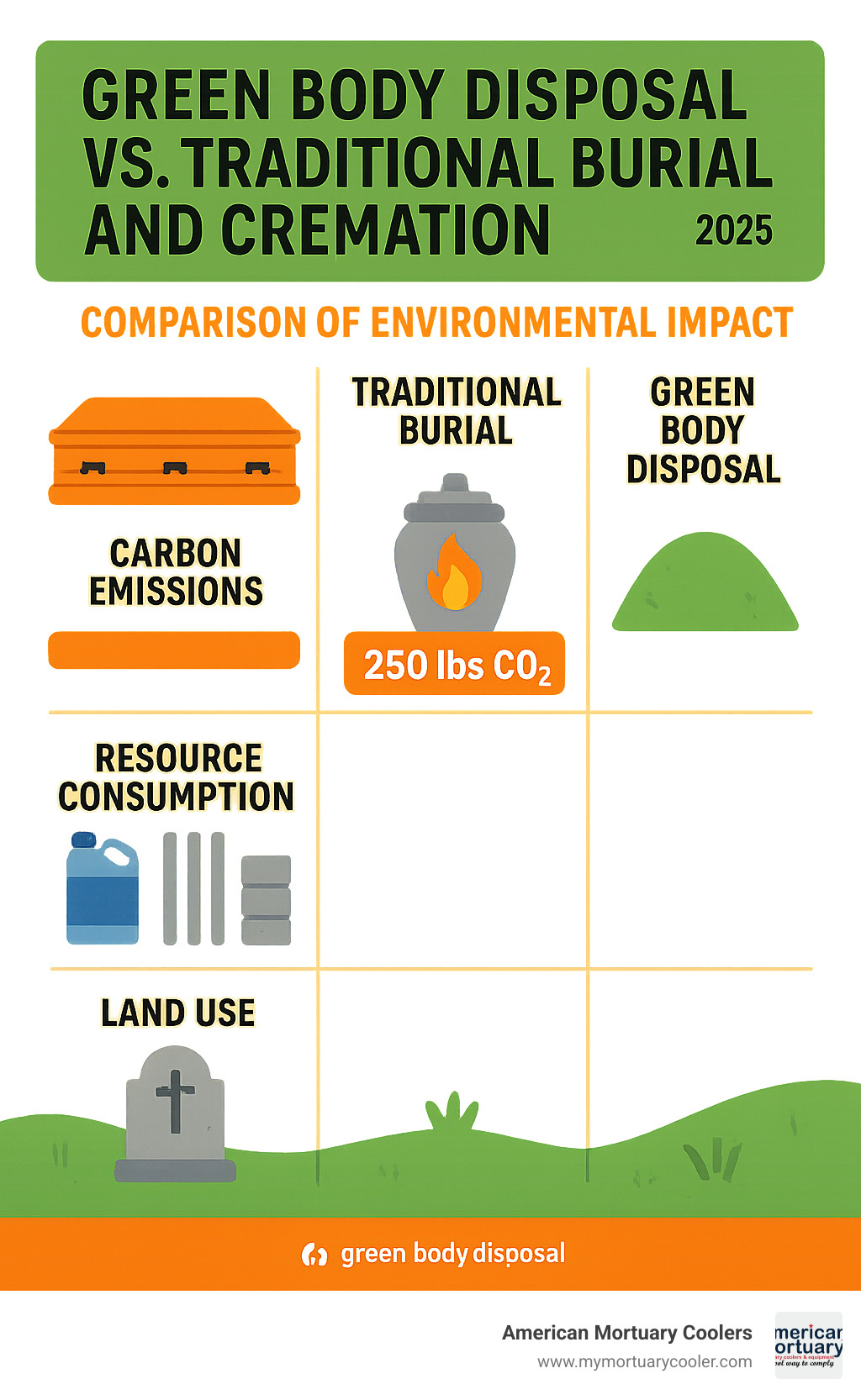
Quick look at green body disposal:
Why the Buzz Around Eco-Friendly Farewells?
Something profound is happening in how we think about death and the environment. When families find that traditional funerals consume 77,000 trees annually just for caskets, they start questioning whether there's a better way to honor their loved ones.
The numbers behind conventional death care are eye-opening. Every year in the U.S., funeral homes use 800,000 gallons of toxic embalming chemicals containing formaldehyde - a known carcinogen that threatens both funeral workers and groundwater systems. A 2009 National Cancer Institute study found that funeral directors face significantly higher rates of myeloid leukemia, likely due to formaldehyde exposure.
Even cremation carries a substantial carbon footprint. Each cremation produces emissions equivalent to driving 500 miles and requires enormous amounts of energy. When you consider that 75% of Canadians now choose cremation, those emissions add up quickly.
Climate change has fundamentally shifted family conversations about legacy and environmental impact. Demographic shifts matter too - environmentally conscious millennials and Gen X are now planning end-of-life arrangements with sustainability in mind.
Cost pressures also drive interest in green body disposal alternatives. Traditional funerals averaging $7,000-$9,000 feel increasingly out of reach for many families. Green burials costing just $1,000-$2,000 offer both environmental benefits and budget relief.
The environmental math is compelling. Traditional cemeteries contribute to methane emissions while consuming valuable land. Embalming chemicals leach into soil and groundwater systems for decades. Meanwhile, green burial grounds actually sequester carbon while creating protected natural spaces.
Media coverage of climate impacts has made consumers more aware that every choice matters - including their final one. Families want their farewell to reflect their values, not contradict them. Green body disposal methods aren't just trendy - they're becoming essential services for meeting evolving consumer expectations.
Understanding Green Body Disposal Methods
Green body disposal represents a profound shift toward regenerative philosophy - the idea that our final act can nourish new life rather than consume resources. The best green disposal methods actively benefit the planet through habitat protection, nutrient cycling, and ecosystem restoration.
Green Burial 101
Green burial returns us to humanity's most natural way of caring for the dead - placing the body directly in the earth to decompose as nature intended. No concrete vaults trapping the body underground. No metal caskets lasting centuries. No harsh embalming chemicals contaminating soil.
Bodies are wrapped in biodegradable shrouds made from materials like linen, cotton, or silk. Some families choose simple wooden caskets from sustainably harvested timber. Graves are hand-dug to about 48 inches deep - shallow enough to support microbial activity but deep enough to prevent odors or animal disturbance.
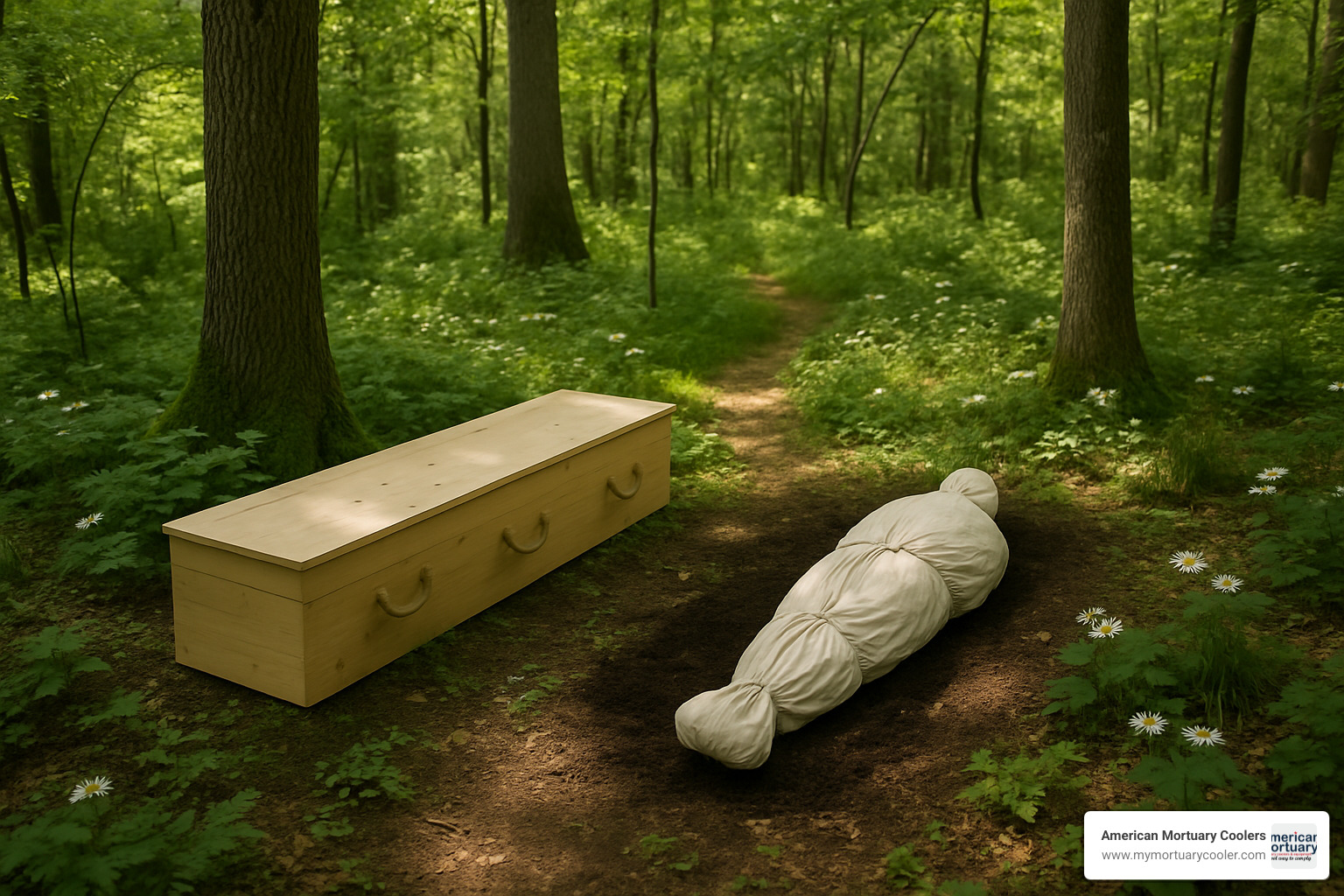
Green cemeteries come in three main types. Dedicated natural burial grounds preserve wild landscapes forever, often doubling as nature preserves. Hybrid cemeteries offer green sections alongside traditional plots. Green-friendly conventional cemeteries allow vault-free burials and biodegradable containers.
Tree memorials replace traditional headstones, providing wildlife habitat while pulling carbon from the atmosphere. Some families plant native species supporting local birds and butterflies. Others choose fruit trees that will nourish future generations.
Canada currently has only about 15 certified green burial sites, compared to hundreds in the U.S. and UK. The Green Burial Society of Canada sets standards and certifies providers, ensuring authentic green practices.
For detailed information about implementing eco-friendly practices, check out our guide on eco-friendly funerals.
Water Cremation (Alkaline Hydrolysis)
Alkaline hydrolysis - also called aquamation or water cremation - uses 90% less energy than traditional flame cremation while producing zero direct emissions. The body is placed in a pressurized stainless steel vessel with a solution that's 95% water and 5% potassium hydroxide, then heated to about 302°F.
Over 2-3 hours, this alkaline solution gently accelerates the same natural decomposition that happens in soil. The process breaks down tissues while preserving bone fragments, with no risk of explosion from pacemakers or medical devices.
The sterile liquid byproduct can be safely processed through municipal water treatment systems. The process preserves about 20% more bone fragments than flame cremation, and the bone ash is lighter in color.
Currently, alkaline hydrolysis is legal in Saskatchewan, Ontario, Quebec, Newfoundland and Labrador, and the Northwest Territories. Several other provinces are considering legislation as demand grows.
Our analysis of water cremation benefits explores how funeral homes can implement this technology.
Human Composting & Natural Organic Reduction
Human composting transforms human remains into nutrient-rich soil through controlled aerobic decomposition. Bodies are layered with organic materials like wood chips, straw, and sawdust in specialized vessels. Getting the carbon-to-nitrogen ratio right - about 25-30:1 - is crucial for healthy decomposition.
Over the 30-day composting cycle, temperatures stay between 130°F-160°F, hot enough to eliminate pathogens while supporting beneficial microbes. After composting, the material goes through another 30-day curing period before screening removes inorganic materials.
Each person yields approximately 1-2 cubic yards of finished compost - enough to nourish a small memorial garden or contribute to habitat restoration projects. Families can participate through laying-in ceremonies, decorating vessels, and visiting throughout the process.
The process is legal in Washington, Oregon, Colorado, Vermont, and California (starting in 2027). Costs typically range from $2,500-$5,000.
For funeral directors considering this service, our guide to human body composting covers equipment requirements.
Burial at Sea & Emerging Concepts
Full-body sea burial uses biodegradable shrouds or specially designed caskets that dissolve harmlessly in saltwater. Some companies create artificial reefs by mixing cremated remains with eco-friendly concrete, supporting marine habitat restoration.
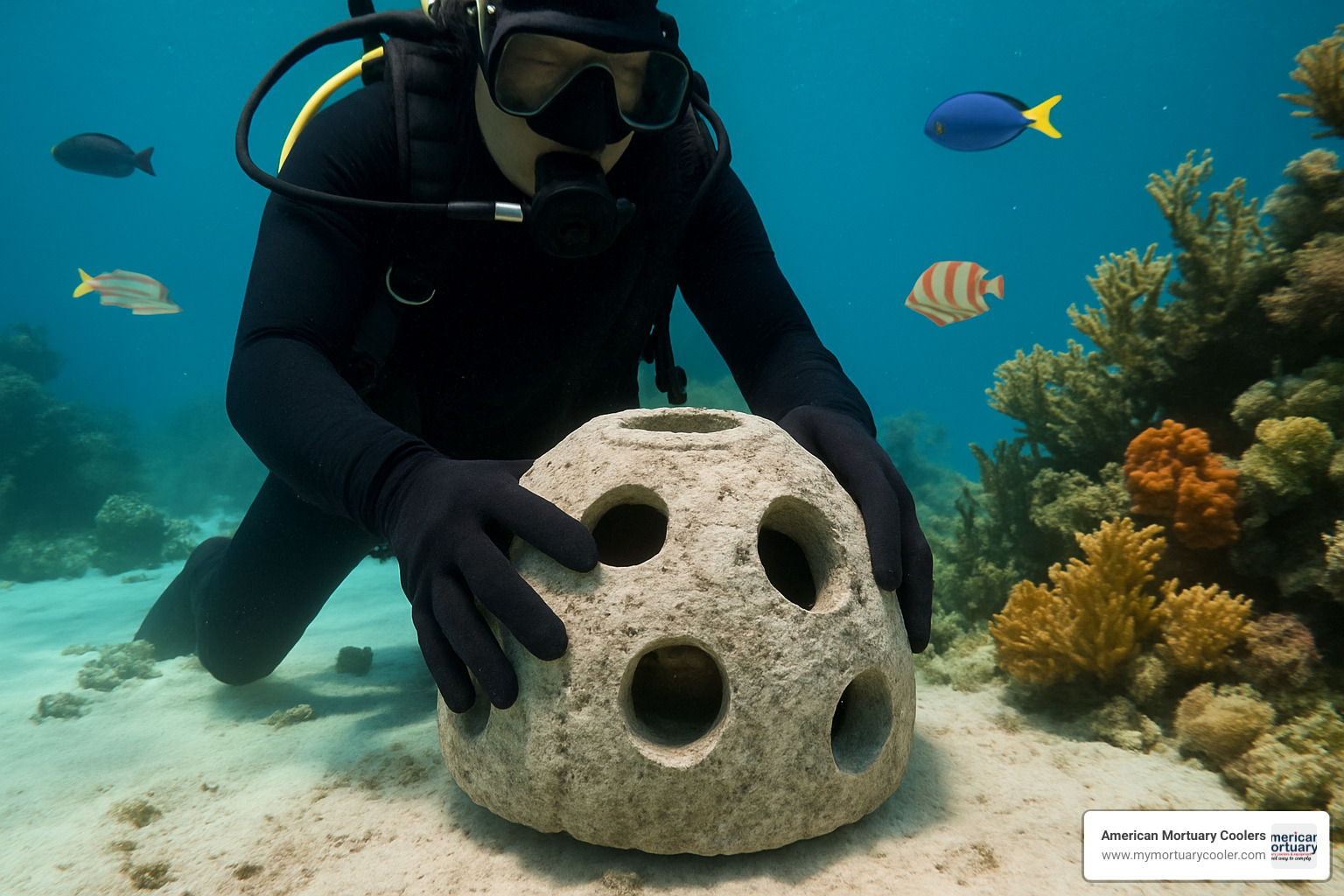
Emerging concepts include tree burial pods that place cremated remains in biodegradable containers designed to nourish growing trees, though success rates vary. Mushroom burial suits claim to use fungi for toxin remediation, but scientific evidence remains limited. Some experimental approaches like freeze-drying have struggled to achieve commercial viability due to technical challenges.
Environmental Benefits and Potential Risks
When it comes to green body disposal, the environmental benefits are impressive. Research shows that when soil organic matter increases by just 1%, it can hold an extra 20,000 gallons of water per acre - like natural drought insurance.
Green burial creates significant environmental wins. Instead of consuming massive amounts of steel, concrete, and chemicals, it actually protects ecosystems permanently. Conservation burial grounds don't just reduce harm - they actively preserve wildlife habitat and store carbon for generations.
Traditional cemeteries are essentially concrete parking lots for the dead. Green burial grounds become living memorials where native plants provide food and shelter for wildlife while preventing soil erosion.
Human composting takes this regenerative approach further. Each person creates enough nutrient-rich soil to nourish a small memorial garden - soil that's tested and proven safe for growing plants. Some facilities donate excess compost to habitat restoration projects.
Potential risks need addressing. Some worry about pharmaceutical residues from medications. Studies consistently show these concentrations are typically too low to cause ecological harm.
Infectious disease concerns arise, but the CDC and WHO confirm that unembalmed bodies pose no measurable public health risk when handled properly. Pathogens die off rapidly after death, and beneficial soil microbes create environments hostile to harmful bacteria.
For human composting, proper facility management is crucial. Temperature monitoring ensures pathogen elimination - those 130°F-160°F temperatures aren't just for decomposition, they're a built-in safety system.
Alkaline hydrolysis produces completely sterile effluent, safer than what comes from most hospital laundry systems. The main consideration is pH adjustment before entering municipal water treatment.
Site selection matters for green burial. Adequate drainage and distance from water sources minimize groundwater risks using the same principles that govern septic systems.
Here's what the numbers tell us:
| Method | Carbon Emissions | Energy Use | Land Impact | Water Quality Risk |
|---|---|---|---|---|
| Traditional Burial | High (concrete, steel) | Moderate | Permanent land use | High (embalming chemicals) |
| Cremation | High (250 lbs CO2) | Very High | Minimal | Low |
| Green Burial | Very Low | Minimal | Positive (habitat) | Very Low |
| Alkaline Hydrolysis | Low | Low (90% less) | Minimal | Very Low |
| Human Composting | Very Low | Low | Positive (soil creation) | Very Low |
Green body disposal methods deliver significant environmental benefits when implemented responsibly. The risks are manageable with proper protocols - much more manageable than the guaranteed environmental damage from traditional methods.
Legal Landscape, Costs, and Accessibility in Canada & Beyond
Navigating the legal landscape for green body disposal in Canada feels like following a patchwork quilt - what's legal in one province might not be available across the border. The regulatory framework shifts dramatically depending on location.
Green burial enjoys broad acceptance across Canada, though only about 15 certified sites currently operate nationwide. Provincial governments handle cemetery regulations, while federal oversight covers infectious disease control.
Alkaline hydrolysis is more complex. Saskatchewan, Ontario, Quebec, Newfoundland and Labrador, and the Northwest Territories have accepted this technology. Other provinces are considering similar legislation as consumer demand grows.
Human composting remains unavailable anywhere in Canada, leaving interested families to look south. Washington State has become a destination for Canadian families, with facilities handling cross-border arrangements.
The Green Burial Society of Canada serves as the primary certification body, helping consumers distinguish authentic green providers from greenwashing.
Geographic coverage remains limited outside major urban centers. Rural families often face significant travel to reach certified facilities, adding cost and complexity.
Basic green burial plots typically range from $1,000 to $3,000, while comprehensive packages can reach $5,000. Alkaline hydrolysis generally costs $2,000 to $4,000, competitive with traditional cremation.
Insurance coverage for green methods is improving but remains inconsistent. Some policies exclude newer technologies, treating them as experimental rather than established practices.
Pre-planning has become increasingly important as families steer coverage limitations and budget for services that may not be available locally.
Current Canadian Providers & Directories for Green Body Disposal
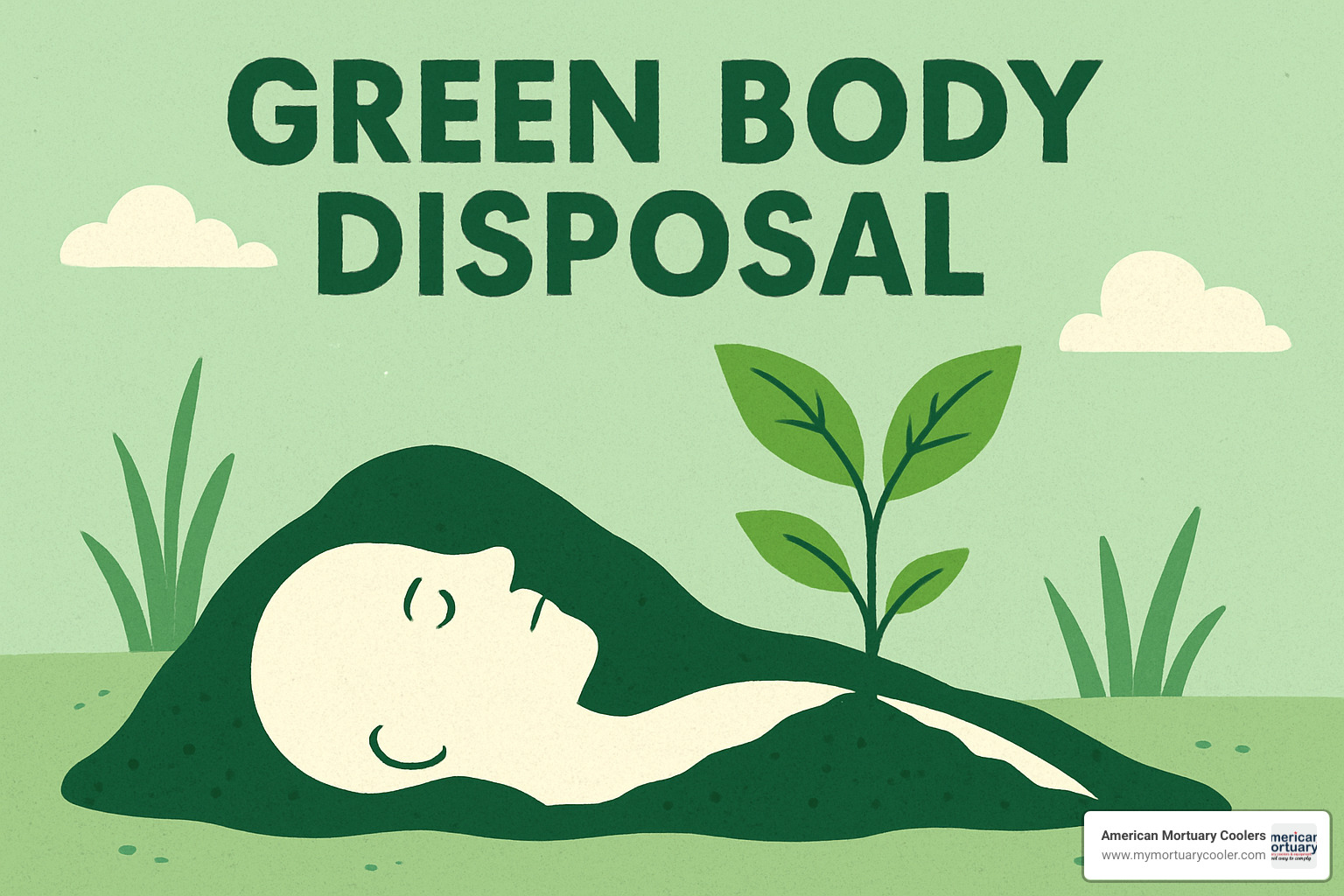
Finding certified green body disposal providers in Canada requires detective work, but the Green Burial Society of Canada maintains the most reliable directory.
British Columbia leads in innovation and consumer awareness, though regulatory challenges have slowed adoption. Alberta presents a more challenging landscape with limited options. Ontario boasts the largest number of certified green burial sites in Canada, with alkaline hydrolysis available through licensed providers.
Quebec offers a fascinating blend of traditional influences and environmental innovation. Alkaline hydrolysis gained legal status relatively early. The Atlantic Provinces hold special significance - Denman Island featured Canada's first natural burial ground.
Cross-border services have become common as Canadian families seek unavailable options. Return Home in Washington State serves families from all Canadian provinces, handling complex logistics of transportation and regulatory compliance.
Major service hubs include Toronto, Vancouver, Montreal, and Halifax, where families can typically find multiple certified providers within reasonable distance.
Budget Breakdown & Funding Tips
Green burial represents the most budget-friendly option, with plot fees typically $1,000 to $3,000. Shrouds or simple caskets add $200 to $1,500, while grave services cost $500 to $1,000.
Alkaline hydrolysis costs break down with basic service fees running $1,500 to $2,500 and facility charges adding $300 to $500.
Hidden expenses can catch families off-guard. Some green cemeteries require annual maintenance fees. Transportation to distant facilities can add significant costs.
Funding strategies include pre-planning to lock in current prices, charitable land trusts offering reduced-cost options, and simple memorial alternatives like tree plantings costing far less than traditional monuments.
Insurance considerations require careful review since coverage varies dramatically between providers and policies.
Cultural, Religious, and Social Considerations
Green body disposal methods align naturally with many faith traditions that emphasize returning to the earth and avoiding excessive materialism. Jewish and Islamic burial practices have long used simple shrouds and avoided embalming, making green burial a natural fit. Some Indigenous traditions view alkaline hydrolysis favorably because it preserves bones for ceremonial purposes.
However, cultural acceptance varies widely. Some families worry that green methods seem "undignified" or lack the permanence of traditional monuments. Others accept the opportunity to create living memorials that support wildlife and ecosystem health.
Grief support becomes especially important with green methods since they often involve more family participation. Carrying the body, filling the grave, or participating in laying-in ceremonies can be deeply healing but may overwhelm some mourners.
Community land trusts and conservation burial grounds create opportunities for collective environmental action. Families can contribute to habitat restoration, carbon sequestration, and biodiversity protection while honoring their loved ones.
Best Practices to Maximize Benefits & Minimize Harm
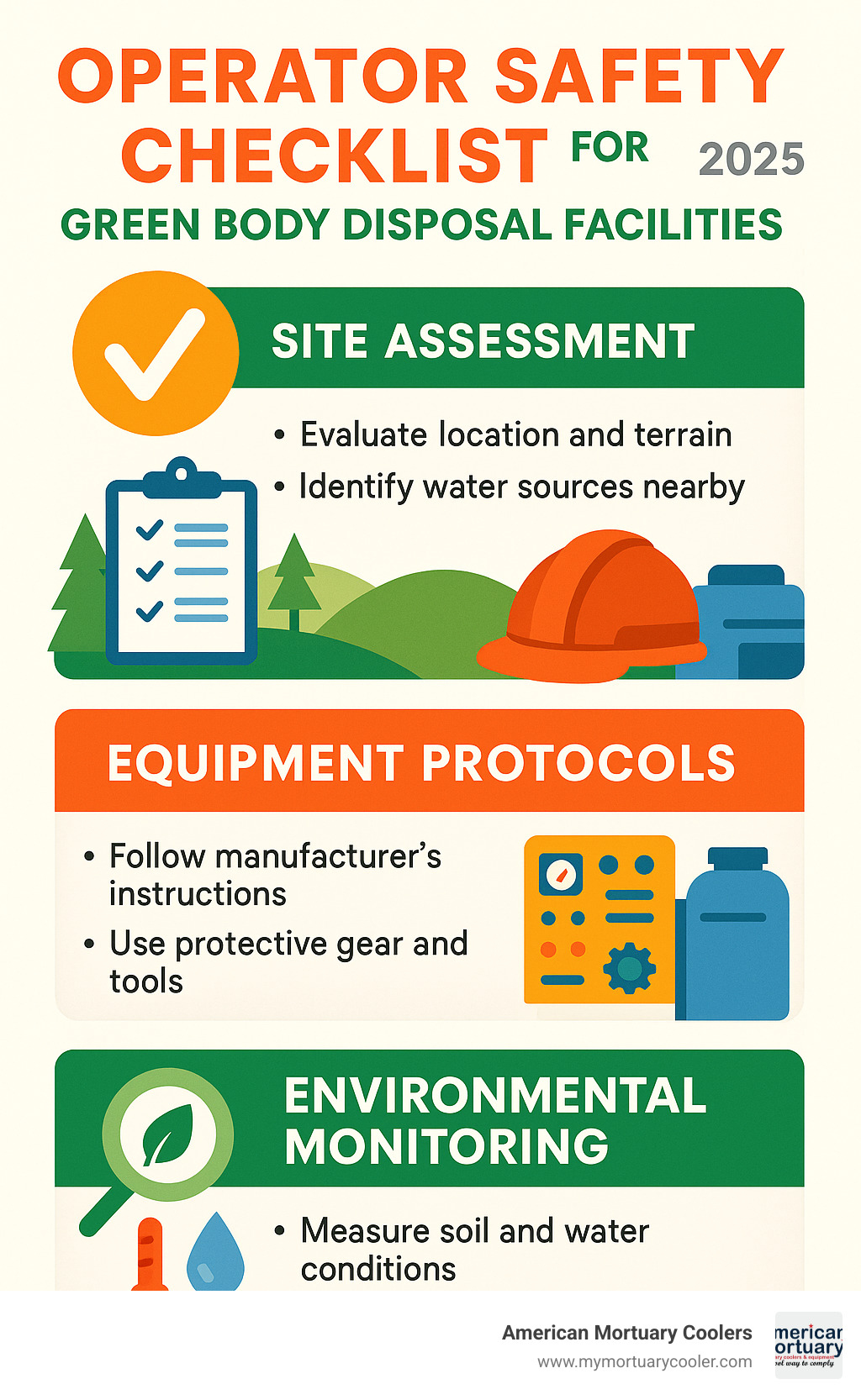
Successful green body disposal operations require careful attention to environmental protection and public health:
Site Assessment Guidelines:
- Conduct geological surveys to assess soil drainage and composition
- Maintain minimum distances from water sources and wells
- Test soil pH and nutrient levels before and after burials
- Monitor groundwater quality in surrounding areas
Operational Protocols:
- Remove pacemakers and radioactive medical devices before processing
- Follow manufacturer specifications for temperature, pH, and duration in alkaline hydrolysis
- Implement integrated pest management at burial grounds
- Use biofilters and setback distances to control odors from composting facilities
Safety Measures:
- Provide comprehensive training on equipment operation and safety procedures
- Maintain proper ventilation and air filtration systems
- Conduct regular testing of finished compost for pathogens and heavy metals
- Follow Radiation Protection Guidelines to exclude recent medical treatments
Family Education:
- Provide clear information about the decomposition process and timeline
- Offer guidance on safe visitation of unembalmed bodies
- Explain environmental benefits and potential limitations honestly
- Support families in choosing appropriate memorial options
Frequently Asked Questions about Green Body Disposal
When families first hear about green body disposal, they often have the same concerns. Let me address the most common questions from funeral directors and families exploring these eco-friendly options.
What exactly qualifies as "green body disposal"?
Not every "natural" or "eco-friendly" service truly qualifies as green body disposal. Real green methods must eliminate toxic chemicals, dramatically reduce energy use, and work with natural decomposition instead of fighting it.
The Green Burial Council has created clear standards to prevent greenwashing. Authentic green disposal avoids embalming fluids, concrete vaults, metal caskets, and synthetic materials that won't break down naturally. Bodies go into the earth in organic containers like simple wood caskets or natural fiber shrouds, allowing complete decomposition.
Is green body disposal legal everywhere in Canada?
Green burial is legal throughout Canada, though each province handles cemetery regulations differently. You can choose vault-free burial and biodegradable containers in most areas, but specific requirements vary.
Alkaline hydrolysis has gained legal approval in Saskatchewan, Ontario, Quebec, Newfoundland and Labrador, and the Northwest Territories. Several other provinces are reviewing legislation.
Human composting isn't available anywhere in Canada yet, though some families travel to Washington State for this service.
How safe is the compost or effluent produced?
Human composting maintains temperatures between 131°F and 160°F for weeks, which eliminates dangerous pathogens. Finished compost gets laboratory tested before use, ensuring it meets safety standards.
Alkaline hydrolysis produces completely sterile liquid that can safely go through municipal water treatment systems. The high pH needs adjustment, but the dissolved organic matter provides nutrients that benefit aquatic ecosystems when properly processed.
Both processes can concentrate pharmaceutical residues from medications the person took during life. However, research shows these levels are typically too low to cause environmental problems. The key is working with certified providers who follow proper protocols and conduct regular testing.
Conclusion
The future of death care is changing, and green body disposal sits at the heart of this change. What started as a niche environmental movement has become a practical solution for families who want to honor their loved ones while protecting the planet we leave behind.
Think about it - every year we bury enough steel to build the Golden Gate Bridge and pump millions of gallons of toxic chemicals into our soil. Meanwhile, cremation burns through energy like there's no tomorrow. Green body disposal methods flip this script entirely.
When you choose green burial, alkaline hydrolysis, or human composting, you're not just making an environmental statement. You're often saving thousands of dollars while creating something beautiful - whether that's a forest habitat, clean water, or rich soil that will nourish life for decades to come.
At American Mortuary Coolers, we've been supporting funeral homes through this transition for years. Our custom mortuary coolers and specialized equipment help funeral directors offer these services safely and profitably. We've seen how the right equipment makes all the difference in temperature control and storage - especially crucial for green methods that rely on natural processes.
The legal landscape keeps expanding too. More provinces are embracing alkaline hydrolysis, and green burial options are popping up across the country. Funeral homes that get ahead of this curve are positioning themselves perfectly for the future.
For families reading this, green body disposal offers something traditional methods simply can't - the chance to give back even in death. Your final act becomes one of regeneration rather than consumption. Your memorial garden grows instead of gathering dust. Your legacy lives on in the trees, the soil, and the wildlife your choice helps protect.
Of course, not every "green" option is truly green. Some companies slap eco-friendly labels on conventional services without changing much underneath. That's why working with certified providers who follow real standards matters so much.
The conversation around sustainable death care is just getting started. As climate awareness grows and costs keep rising, more families will seek alternatives that align with their values and budgets. Green body disposal methods offer exactly that - meaningful, affordable options that benefit everyone.
Ready to dive deeper into eco-friendly funeral practices? Our comprehensive guide on eco-friendly funerals covers everything you need to know about equipment selection, regulations, and service development. Whether you're a funeral director exploring new offerings or a family planning ahead, you'll find the practical information you need to make informed decisions about sustainable death care.
















